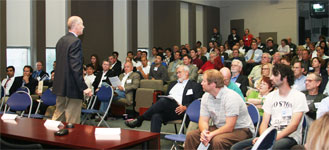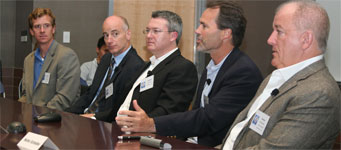Clean, Green and ? Profitable
Irvine, Calif., May 27, 2009 -- The hot topic of clean energy drew nearly 200 people to the Calit2 Auditorium at UC Irvine May 14. The crowd was attending the institute’s most recent Igniting Technology event featuring the latest advances in clean, green and renewable energy opportunities and technologies.
|
“The Clean Energy Challenge” highlighted pioneering research to create sustainable systems underway at UCI, as well as a peek into current and future markets and funding opportunities.
Five presenters shared their expertise with the overflow crowd. From research into nanomaterial-based solar cells and clean fuel-cell systems to new business strategies and market forecasts, the rapidly growing “cleantech” field appears to have a bright future.
Michael Guiliana, a partner at intellectual property law firm and event co-sponsor Knobbe, Martens, Olson & Bear, moderated the presentation, singling out Calit2 for its success in launching new technologies into the marketplace. “Calit2 is fast becoming one of the finest university-backed incubators in the country,” he said.
Brian Kremer, representing ROTH Capital Partners in Newport Beach, told the audience that great ideas are not enough. Explaining that his firm acts as a broker between companies and potential investors, he said that new companies must demonstrate profitability as well as cutting-edge technology. “If you want to raise money you have to prove to investors that your company is sustainable, can make money and makes economic sense,” he said. “Just being green isn’t good enough anymore, particularly in this tough economic environment.”
The current market for new energy technology is the result of increased standards of living in much of the world, Kremer said, adding that projected growth of renewable energy companies is increasing exponentially.
Reg Penner, chemistry professor and director of UCI’s Center for Solar Energy, discussed the center’s efforts to extract and produce energy from the sun in new ways. Various approaches include: designing metal nanoparticles that concentrate light onto semiconductors; devising molecues that can absorb sunlight and separate water into hydrogen and oxygen; developing nanocrystal-semiconductors that can be printed on rolls; and using extremely long nanowires patterned onto glass or silcon wafers to extract energy from long wavelength radiation and waste heat.
Penner said the center, which recently received $2 million from Pres. Obama’s Energy Frontier Research Center program, is focused on understanding the fundamental science behind solar energy. “We’re not interested specifically in making a solar cell in six months or two years, but we want to do the foundational science that you’ll need to build that solar cell,” he said.
|
Verdezyne, an Orange County biotechnology company founded on research that originated at UCI, is developing a cost-efficient alternative to petroleum. “Green is becoming a very real part of consumerism,” business development vice-president Damien Perryman told the audience. “But we need to provide cost advantage in order to drive the adoption rate. We need to ensure that our technology can be used quickly.”
The firm uses synthetic genes and computational pathway engineering to create organisms that produce biofuels during fermentation. “We want to make replacements, not substitutes – chemical products that are made from biology that are identical to what the petrochemical industry uses,” he said.
Perryman echoed the profitability message. “When you look at the petrochemical industry, they need economical solutions in order to be incentivized to switch. No one benefits from technology that can’t be adopted within the industry,” he said. “And we really need industry to get on board to drive the technology adoption.”
Fuel cell expert Jack Brouwer, associate director of UCI’s National Fuel Cell Research Center, believes the non-polluting devices are positioned to contribute to a more sustainable future. Fuel cells have higher efficiency per unit of fuel, lower emissions per unit of energy generated, run on various types of fuel, and can complement other renewable energy sources because they can be operated dynamically. “We should continue to install solar and wind but complement that with dispatchable power like fuel cells,” he said.
He also advocates fuel cells in cars and trucks, citing the success of UCI’s ZEVnet program, which provides a fleet of hybrid fuel-cell vehicles for students, staff and faculty to use for short-range trips. In addition, NFCRC is collaborating with GM and Toyota to test plug-in hybrid electric vehicles that utilize fuel cells, Brouwer said. “And if we can produce [the fuel] from natural energy or biomass, you have even better benefits.”
NFCRC is currently working with the U.S. Department of Energy, and companies Air Products and FuelCell Energy to develop fueling stations that will incorporate high-temperature fuel cells, allowing them to offer electric, thermal and hydrogen options. “This is very exciting technology that will we be installing here in Orange County, hopefully later this year,” Brouwer said.
The evening’s last presenter was Walter Schindler, managing partner of SAIL Venture Partners, LLC, which has been investing in cleantech since 2002, “before all this was fashionable.” Schindler said SAIL, ranked the U.S.’s number one clean investment firm last year by JP Morgan, is investing globally in cleantech companies whose revenues are increasing by leaps and bounds – an average of 85-90 percent a year at an annual compounded rate. Cleantech, Schindler said, is actually the world’s fastest-growing investment category.
SAIL recently invested in a company that manufactures batteries for hybrid and plug-in electric cars. The company was chosen by the state of Michigan as one of three battery manufacturers to receive $700 million in tax credits; SAIL is partnering with Dow Chemical to build additional facilities in Michigan for the Korean company. Schindler said the new plants will supply batteries worldwide for the company, which already has $2.5 billion in orders from European car manufacturers.
Questions about innovation and commercialization were raised several times during the question-and-answer session. Schindler said he sees “enormous innovation” in university labs across the country, but that most people don’t understand how long it takes for innovation to mature. “Technology in labs today won’t be on the shelf in a commercially available form for maybe 10 years,” he said. “The free market will determine which of these technologies gets deployed in the marketplace.”
That free market is influenced by consumer behavior, which all the experts see changing slowly. Kremer said he believes government will need to play a role. “Governments step in when private markets won’t do what needs to be done or what might be in the best interests long-term.” Without incentives from government, he said, “it’ll go by the wayside.”
Brouwer agreed that economics will drive individual consumer decisions but the finite nature of fossil resources is a factor. “Once [we] start valuing the preciousness of the resources and the impact that CO2 has on climate change, [we] can incorporate sustainability into the market.”



